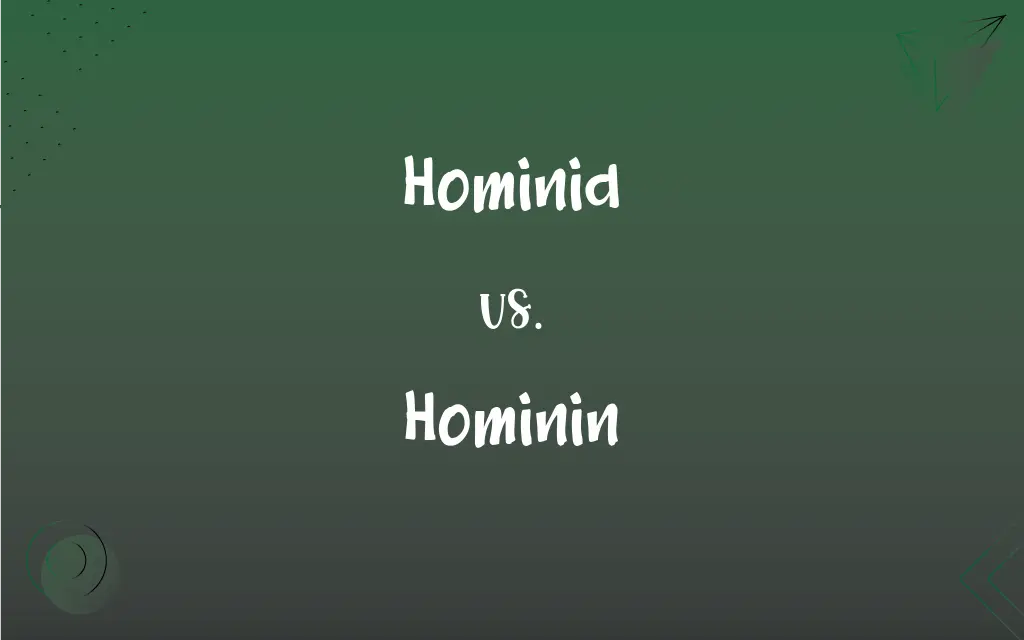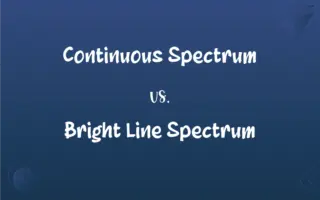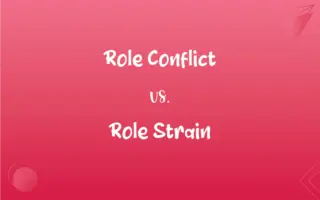Hominid vs. Hominin: What's the Difference?
Edited by Aimie Carlson || By Janet White || Published on January 19, 2024
Hominid refers to family including humans, their ancestors, and great apes; Hominin refers to tribe specifically of humans and their direct ancestors.

Key Differences
Hominids are a broader family that includes all great apes and their ancestors. Hominins, in contrast, refer specifically to the tribe that includes modern humans, Homo sapiens, and their direct ancestors.
Hominids encompass a wider range of species, including gorillas, chimpanzees, and orangutans. Hominins are more narrowly focused on the lineage that led directly to humans.
The term hominid has evolved over time; previously, it was used in a way similar to the current definition of hominin. Hominins have always been characterized by their closer relation to humans than to other apes.
Hominids show a variety of evolutionary adaptations, including those not directly related to human evolution. Hominins are marked by adaptations more specifically relevant to human evolution, such as bipedalism.
The study of hominids gives insights into the broader evolutionary history of great apes, including humans. Research on hominins is more focused on understanding the specific path of human evolution.
ADVERTISEMENT
Comparison Chart
Inclusive Species
Great apes and their ancestors
Humans and direct ancestors
Evolutionary Focus
Broader ape evolution
Direct human evolution
Characteristic Features
Diverse, including non-human traits
More specific to human lineage
Scope
Wider range of species
Narrow, human-centric lineage
Research Relevance
Insights into ape evolution
Understanding human evolution
ADVERTISEMENT
Hominid and Hominin Definitions
Hominid
Broad category in primate evolution.
Studying hominids helps understand the evolution of intelligence.
Hominin
Group including Homo sapiens and ancestors.
Hominin evolution is marked by the development of bipedalism.
Hominid
Members of the biological family Hominidae.
Chimpanzees are hominids, sharing a common ancestor with humans.
Hominin
Tribe within Hominidae, closer to humans.
The discovery of hominin fossils is vital for understanding human ancestry.
Hominid
Taxonomic group including humans and apes.
Hominid fossils provide clues about primate evolution.
Hominin
Classification for human lineage.
Hominins show a progression towards larger brain sizes.
Hominid
Family group in anthropology and biology.
Orangutans are hominids with unique arboreal adaptations.
Hominin
Narrow category focused on human evolution.
The study of hominins sheds light on the origins of language.
Hominid
Classification encompassing all great apes.
Gorillas, as hominids, exhibit complex social behaviors.
Hominin
Humans and their direct evolutionary ancestors.
Early hominins were adept at using primitive tools.
Hominid
Any of various primates of the family Hominidae, which includes orangutans, gorillas, chimpanzees, and modern humans, and their extinct relatives. The family formerly included only Homo sapiens, extinct species of Homo, and the extinct genus Australopithecus.
Hominin
Any of various primates of the tribe Hominini, including Australopithecus, other Pliocene and Pleistocene human relatives, and Homo sapiens, the only extant species. The hominins were formerly referred to as hominids.
Hominid
Any primate of the taxonomic family Hominidae, which includes all the great apes (chimpanzees, gorillas, orangutans) as well as humans.
Hominin
(palaeontology) Any member of the taxonomic tribe Hominini, the evolutionary group that includes modern humans and now-extinct bipedal relatives.
Hominid
Of the Hominidae.
Hominid
A primate of the family Hominidae
Hominid
Characterizing the family Hominidae, which includes Homo sapiens sapiens as well as extinct species of manlike creatures
FAQs
What distinguishes hominins from other hominids?
Hominins are more closely related to humans.
Are all humans considered hominins?
Yes, all modern humans are hominins.
What are hominins?
A tribe specifically of humans and their direct ancestors.
Which species are included in hominids?
Gorillas, chimpanzees, orangutans, and humans.
What is a significant evolutionary trait of hominins?
Bipedalism and larger brain size are significant traits.
Can hominids be bipedal?
While some hominids show bipedal traits, it's a key characteristic of hominins.
How old are the oldest hominin fossils?
The oldest hominin fossils date back over 6 million years.
What are hominids?
A family including humans, great apes, and their ancestors.
Is tool use exclusive to hominins?
While advanced tool use is a hominin trait, some other hominids also use basic tools.
How does studying hominins help in anthropology?
It provides specific insights into human ancestry and evolution.
What are the dietary differences between hominids and hominins?
Hominins tend to have more diverse diets, adapting over time.
Can hominids and hominins interbreed?
There's evidence of interbreeding between some hominin species.
Are Neanderthals considered hominins?
Yes, Neanderthals are classified as hominins.
What's the difference in brain size between hominids and hominins?
Hominins generally exhibit a trend towards larger brain sizes compared to other hominids.
How do hominids contribute to understanding human evolution?
They provide a broader context for the evolution of great apes, including humans.
How do hominids help in understanding primate behavior?
They offer a wider perspective on the evolution of social and cognitive traits.
Are all hominins extinct except for humans?
Yes, Homo sapiens are the only surviving hominins.
Do hominids include extinct species?
Yes, both extinct and extant great apes are hominids.
Are bonobos considered hominids or hominins?
Bonobos are hominids, not hominins.
Are hominins exclusively bipedal?
Bipedalism is a defining trait of hominins, though early hominins may have also climbed.
About Author
Written by
Janet WhiteJanet White has been an esteemed writer and blogger for Difference Wiki. Holding a Master's degree in Science and Medical Journalism from the prestigious Boston University, she has consistently demonstrated her expertise and passion for her field. When she's not immersed in her work, Janet relishes her time exercising, delving into a good book, and cherishing moments with friends and family.
Edited by
Aimie CarlsonAimie Carlson, holding a master's degree in English literature, is a fervent English language enthusiast. She lends her writing talents to Difference Wiki, a prominent website that specializes in comparisons, offering readers insightful analyses that both captivate and inform.








































































